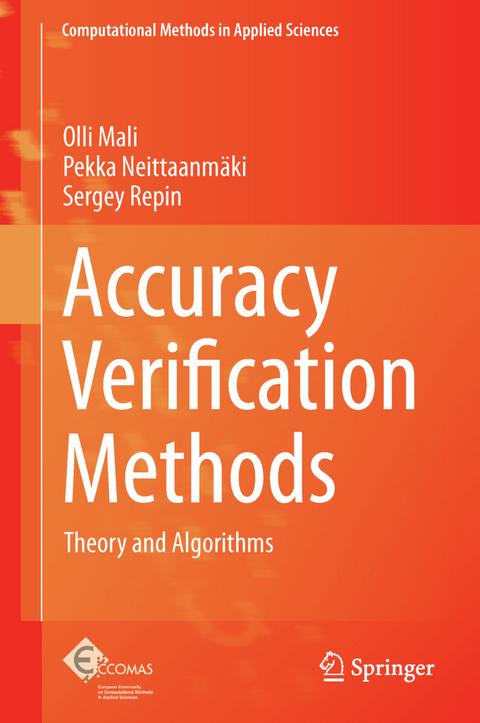
Accuracy Verification Methods
Springer (Verlag)
978-94-007-7580-0 (ISBN)
The importance of accuracy verification methods was understood at the very beginning of the development of numerical analysis. Recent decades have seen a rapid growth of results related to adaptive numerical methods and a posteriori estimates. However, in this important area there often exists a noticeable gap between mathematicians creating the theory and researchers developing applied algorithms that could be used in engineering and scientific computations for guaranteed and efficient error control.
The goals of the book are to (1) give a transparent explanation of the underlying mathematical theory in a style accessible not only to advanced numerical analysts but also to engineers and students; (2) present detailed step-by-step algorithms that follow from a theory; (3) discuss their advantages and drawbacks, areas of applicability, give recommendations and examples.
1 Errors Arising In Computer Simulation Methods.- 1.1 General scheme.- 1.2 Errors of mathematical models.- 1.3 Approximation errors.- 1.4 Numerical errors.- 2 Error Indicators.- 2.1 Error indicators and adaptive numerical methods.- 2.1.1 Error indicators for FEM solutions.- 2.1.2 Accuracy of error indicators.- 2.2 Error indicators for the energy norm.- 2.2.1 Error indicators based on interpolation estimates.- 2.2.2 Error indicators based on approximation of the error functional.- 2.2.3 Error indicators of the Runge type.- 2.3 Error indicators for goal-oriented quantities.- 2.3.1 Error indicators relying on the superconvergence of averaged fluxes in the primal and adjoint problems.- 2.3.2 Error indicators using the superconvergence of approximations in the primal problem.- 2.3.3 Error indicators based on partial equilibration of fluxes in the original problem.- 3 Guaranteed Error Bounds I.- 3.1 Ordinary differential equations.- 3.1.1 Derivation of guaranteed error bounds.- 3.1.2 Computation of error bounds.- 3.2 Partial differential equations.- 3.2.1 Maximal deviation from the exact solution.- 3.2.2 Minimal deviation from the exact solution.- 3.2.3 Particular cases.- 3.2.4 Problems with mixed boundary conditions.- 3.2.5 Estimates of global constants entering the majorant.- 3.2.6 Error majorants based on Poincar´e inequalities.- 3.2.7 Estimates with partially equilibrated fluxes.- 3.3 Error control algorithms.- 3.3.1 Global minimization of the majorant.- 3.3.2 Getting an error bound by local procedures.- 3.4 Indicators based on error majorants.- 3.5 Applications to adaptive methods.- 3.6 Combined (primal-dual) error norms and the majorant.- 4 Guaranteed Error Bounds II.- 4.1 Linear elasticity.- 4.1.1 Introduction.- 4.1.2 Euler–Bernoulli beam.- 4.1.3 The Kirchhoff–Love arch model.- 4.1.4 The Kirchhoff–Love plate.- 4.1.5 The Reissner–Mindlin plate.- 4.1.6 3D linear elasticity.- 4.1.7 The plane stress model.- 4.1.8 The plane strain model.- 4.2 TheStokes Problem.- 4.2.1 Divergence-free approximations.- 4.2.2 Approximations with nonzero divergence.- 4.2.3 Stokes problem in rotating system.- 4.3 A simple Maxwell type problem.- 4.3.1 Estimates of deviations from exact solutions.- 4.3.2 Numerical examples.- 4.4 Generalizations.- 4.4.1 Error majorant.- 4.4.2 Error minorant.- 5 Errors Generated By Uncertain Data.- 5.1 Mathematical models with incompletely known data.- 5.2 The accuracy limit.- 5.3 Estimates of the worst and best case scenario errors.- 5.4 Two-sided bounds of the radius of the solution set.- 5.5 Computable estimates of the radius of the solution set.- 5.5.1 Using the majorant.- 5.5.2 Using a reference solution.- 5.5.3 An advanced lower bound.- 5.6 Multiple sources of indeterminacy.- 5.6.1 Incompletely known right-hand side.- 5.6.2 The reaction diffusion problem.- 5.7 Error indication and indeterminate data.- 5.8 Linear elasticity with incompletely known Poisson ratio.- 5.8.1 Sensitivity of the energy functional.- 5.8.2 Example: axisymmetric model.- 6 Overview Of Other Results And Open Problems.- 6.1 Error estimates for approximations violating conformity.- 6.2 Linear elliptic equations.- 6.3 Time-dependent problems.- 6.4 Optimal control and inverse problems.- 6.5 Nonlinear boundary value problems.- 6.5.1 Variational inequalities.- 6.5.2 Elastoplasticity.- 6.5.3 Problems with power growth energy functionals.- 6.6 Modeling errors.- 6.7 Error bounds for iteration methods.- 6.7.1 General iteration algorithm.- 6.7.2 A priori estimates of errors.- 6.7.3 A posteriori estimates of errors.- 6.7.4 Advanced forms of error bounds.- 6.7.5 Systems of linear simultaneous equations.- 6.7.6 Ordinary differential equations.- 6.8 Roundoff errors.- 6.9 Open problems.- A Mathematical Background.- A.1 Vectors and tensors .- A.2 Spaces of functions.- A.2.1 Lebesgue and Sobolev spaces.- A.2.2 Boundary traces.- A.2.3 Linear functionals.- A.3 Inequalities.- A.3.1 The Hölder inequality.- A.3.2 The Poincaré and Friedrichsinequalities.- A.3.3 Korn’s inequality.- A.3.4 LBB inequality.- A.4 Convex functionals.- B Boundary Value Problems.- B.1 Generalized solutions of boundary value problems.- B.2 Variational statements of elliptic boundary value problems.- B.3 Saddle point statements of elliptic boundary value problems.- B.3.1 Introduction to the theory of saddle points.- B.3.2 Saddle point statements of linear elliptic problems.- B.3.3 Saddle point statements of nonlinear variational problems.- B.4 Numerical methods.- B.4.1 Finite difference methods.- B.4.2 Variational difference methods.- B.4.3 Petrov–Galerkin methods.- B.4.4 Mixed finite element methods.- B.4.5 Trefftz methods.- B.4.6 Finite volume methods.- B.4.7 Discontinuous Galerkin methods.- B.4.8 Fictitious domain methods.- C A Priori Verification Of Accuracy.- C.1 Projection error estimate.- C.2 Interpolation theory in Sobolev spaces.- C.3 A priori convergence rate estimates.- C.4 A priori error estimates for mixed FEM.- References.- Notation.- Index.
| Erscheint lt. Verlag | 11.11.2013 |
|---|---|
| Reihe/Serie | Computational Methods in Applied Sciences ; 32 |
| Zusatzinfo | 75 Illustrations, black and white; XIII, 355 p. 75 illus. |
| Verlagsort | Dordrecht |
| Sprache | englisch |
| Maße | 155 x 235 mm |
| Themenwelt | Informatik ► Theorie / Studium ► Künstliche Intelligenz / Robotik |
| Mathematik / Informatik ► Mathematik ► Analysis | |
| Mathematik / Informatik ► Mathematik ► Angewandte Mathematik | |
| Mathematik / Informatik ► Mathematik ► Wahrscheinlichkeit / Kombinatorik | |
| Naturwissenschaften ► Physik / Astronomie | |
| Schlagworte | Numerical analysis • Verification Methods |
| ISBN-10 | 94-007-7580-6 / 9400775806 |
| ISBN-13 | 978-94-007-7580-0 / 9789400775800 |
| Zustand | Neuware |
| Haben Sie eine Frage zum Produkt? |
aus dem Bereich


